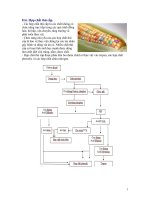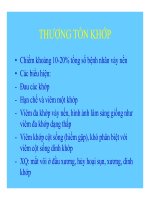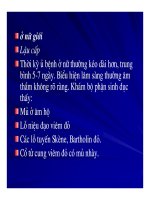bài giảng vẽ cán phần 4 pdf
Bạn đang xem bản rút gọn của tài liệu. Xem và tải ngay bản đầy đủ của tài liệu tại đây (319.28 KB, 10 trang )
31
61
ME 4563 Fall ’05 Dr. S. Haran
•
•
Use Lower Reductions
Use Lower Reductions
This may increase the number of required passes, thus
This may increase the number of required passes, thus
requiring:
requiring:
More time
More time
Possibly more equipment requirements
Possibly more equipment requirements
Possibly more energy
Possibly more energy
•
•
Increase the Work piece Temperature
Increase the Work piece Temperature
This lowers the yield point
This lowers the yield point
This allow
This allow
recrystallization
recrystallization
and reduces strain hardening
and reduces strain hardening
•
•
Apply Tension
Apply Tension
Either side will reduce the force
Either side will reduce the force
If applied at the entrance, termed back tension
If applied at the entrance, termed back tension
If applied at the exit, termed front tension
If applied at the exit, termed front tension
Reducing the Roll Force
Reducing the Roll Force
62
ME 4563 Fall ’05 Dr. S. Haran
Lubricants
Lubricants
…
…
Normally none used for rolling Ferrous alloys; Graphite
Normally none used for rolling Ferrous alloys; Graphite
may be used sometimes
may be used sometimes
Water
Water
-
-
based solutions are used to cool the rolls
based solutions are used to cool the rolls
Non
Non
-
-
ferrous alloys are hot
ferrous alloys are hot
-
-
rolled with variety of
rolled with variety of
lubricants such as oils and fatty acids
lubricants such as oils and fatty acids
Cold rolling is carried out with low
Cold rolling is carried out with low
-
-
viscosity lubricants
viscosity lubricants
such
such
as mineral oils, paraffin, etc.
as mineral oils, paraffin, etc.
Rolling Mills
Rolling Mills
-
-
Lubricants
Lubricants
32
63
ME 4563 Fall ’05 Dr. S. Haran
•
•
Significant effect on product Quality and Productivity
Significant effect on product Quality and Productivity
•
•
Chatter (self excited vibration) can occur in rolling as well
Chatter (self excited vibration) can occur in rolling as well
as
as
other processes (extrusion, drawing, machining, etc.)
other processes (extrusion, drawing, machining, etc.)
•
•
Related to the dynamics of the rolling action
Related to the dynamics of the rolling action
•
•
In Rolling
In Rolling
–
–
predominantly occurs in Tandem mills
predominantly occurs in Tandem mills
•
•
variation in thickness, poor surface finish, high levels of
variation in thickness, poor surface finish, high levels of
scrap
scrap
•
•
frequencies related to the resonance as well as other natural
frequencies related to the resonance as well as other natural
frequencies of the system
frequencies of the system
•
•
Controlled by process parameters: distance between roll sets,
Controlled by process parameters: distance between roll sets,
width of job, speed of rolling, increasing damping, etc.
width of job, speed of rolling, increasing damping, etc.
Rolling
Rolling
–
–
Vibration and Chatter
Vibration and Chatter
64
ME 4563 Fall ’05 Dr. S. Haran
•
•
The forces of rolling will flatten the rollers elastically
The forces of rolling will flatten the rollers elastically
–
–
similar to tires on the road surface
similar to tires on the road surface
(Roll radius,
(Roll radius,
Modulus of elasticity, roll forces)
Modulus of elasticity, roll forces)
•
•
This flattening causes an increase in the contact
This flattening causes an increase in the contact
area
area
•
•
The increased contact area causes the forces to
The increased contact area causes the forces to
increase
increase
•
•
Roll Flattening can be reduced by:
Roll Flattening can be reduced by:
•
•
Using a roller material with a higher modulus of
Using a roller material with a higher modulus of
elasticity
elasticity
•
•
Reducing the roll force
Reducing the roll force
Rolling
Rolling
–
–
Problems with Rolls
Problems with Rolls
Roll Flattening
Roll Flattening
33
65
ME 4563 Fall ’05 Dr. S. Haran
Roll Deflection
Roll Deflection
• Roll forces tend to bend the rolls: leading to a strip
that is thicker at the center than at the edges
•Solution: Grind the rolls such that the diameter at
the center is slightly larger than at the edges
• This is known as giving them CAMBER –In
practice, this would generally be around 0.25 mm
or less on the radius. Camber is only correct for a
• given load on the roll
• thickness of the strip
Hence normally done for a large batch, due to
economic reasons
Rolling
Rolling
–
–
Problems with Rolls
Problems with Rolls
66
ME 4563 Fall ’05 Dr. S. Haran
(a)
(a)
Bending of straight
Bending of straight
cylindrical rolls,
cylindrical rolls,
caused by the roll
caused by the roll
force.
force.
(b)
(b)
Bending of rolls
Bending of rolls
ground with camber,
ground with camber,
producing a strip
producing a strip
with uniform
with uniform
thickness.
thickness.
Roll
Roll
Deflection
Deflection
Rolling
Rolling
–
–
Problems with Rolls
Problems with Rolls
34
67
ME 4563 Fall ’05 Dr. S. Haran
Spreading
Spreading
•
•
Rolling plates sometimes causes the
Rolling plates sometimes causes the
width to increase considerably
width to increase considerably
•
•
This increase is called
This increase is called
SPREADING
SPREADING
•
•
Controlled with:
Controlled with:
•
•
high width
high width
-
-
to
to
-
-
thickness ratio
thickness ratio
•
•
roll radius to strip thickness
roll radius to strip thickness
ratio
ratio
•
•
decreasing friction between rolls
decreasing friction between rolls
and material
and material
Spreading can be observed when
Spreading can be observed when
dough is rolled with a rolling pin.
dough is rolled with a rolling pin.
Rolling
Rolling
–
–
Problems with Rolls
Problems with Rolls
68
ME 4563 Fall ’05 Dr. S. Haran
Successful Rolling depends upon various factors
Successful Rolling depends upon various factors
including material properties, process variables, and
including material properties, process variables, and
lubrication
lubrication
•
•
Defects:
Defects:
•
•
on the
on the
surface
surface
of the rolled material
of the rolled material
•
•
structural defects
structural defects
within the rolled material
within the rolled material
•
•
Surface Defects:
Surface Defects:
•
•
inclusions and impurities in the material
inclusions and impurities in the material
•
•
scale, rust, dirt, roll marks, etc., caused due to
scale, rust, dirt, roll marks, etc., caused due to
prior treatment and working of the material
prior treatment and working of the material
•
•
Remedy:
Remedy:
precondition the material by cleaning
precondition the material by cleaning
it by
it by
various means
various means
Defects due to Rolling
Defects due to Rolling
35
69
ME 4563 Fall ’05 Dr. S. Haran
•
•
Structural Defects:
Structural Defects:
distort or affect the integrity of
distort or affect the integrity of
the rolled product
the rolled product
•
•
Wavy Edges
Wavy Edges
–
–
Edges are thinner than the center
Edges are thinner than the center
caused by bending of the rolls
caused by bending of the rolls
•
•
the edges elongate more then the center and
the edges elongate more then the center and
are restrained from expanding freely, they
are restrained from expanding freely, they
“
“
buckle
buckle
”
”
•
•
Cracks
Cracks
in the Rolled Product
in the Rolled Product
–
–
usually caused by
usually caused by
low ductility and barreling (in the edges & middle)
low ductility and barreling (in the edges & middle)
•
•
Alligatoring
Alligatoring
–
–
resulting from inhomogeneous
resulting from inhomogeneous
material deformation during rolling and defects in
material deformation during rolling and defects in
the original cast ingot itself
the original cast ingot itself
Defects due to Rolling
Defects due to Rolling
70
ME 4563 Fall ’05 Dr. S. Haran
Schematic
Schematic
illustration of
illustration of
typical defects in
typical defects in
flat rolling:
flat rolling:
(a)
(a)
wavy edges;
wavy edges;
(b)
(b)
zipper cracks in
zipper cracks in
the
the
center
center
of the
of the
strip;
strip;
(c)
(c)
edge cracks;
edge cracks;
and
and
(d)
(d)
alligatoring
alligatoring
.
.
Defects due to Rolling
Defects due to Rolling
36
71
ME 4563 Fall ’05 Dr. S. Haran
Defects due to Rolling
Defects due to Rolling
72
ME 4563 Fall ’05 Dr. S. Haran
Defects due to Rolling
Defects due to Rolling
37
73
ME 4563 Fall ’05 Dr. S. Haran
Taking care of wavy edges
Taking care of wavy edges
Defects due to Rolling
Defects due to Rolling
74
ME 4563 Fall ’05 Dr. S. Haran
Defects due to Rolling
Defects due to Rolling
Taking care of wavy
Taking care of wavy
edges
edges
38
75
ME 4563 Fall ’05 Dr. S. Haran
Hot Rolling
Hot Rolling
76
ME 4563 Fall ’05 Dr. S. Haran
•
•
Hot Rolling is done between 100 and 200 degrees F
Hot Rolling is done between 100 and 200 degrees F
above the re
above the re
-
-
crystallization temperature for
crystallization temperature for
most metals
most metals
•
•
Hot rolling gives a final product with a fine grain
Hot rolling gives a final product with a fine grain
size and little strain hardening
size and little strain hardening
•
•
This provides increased material yield strength
This provides increased material yield strength
•
•
This also provides increased ductility, by breaking
This also provides increased ductility, by breaking
grain
grain
boundaries, closing internal defects and
boundaries, closing internal defects and
breaking inclusions
breaking inclusions
Hot Rolling
Hot Rolling
39
77
ME 4563 Fall ’05 Dr. S. Haran
Stresses lower
Stresses lower
Forces smaller
Forces smaller
Power requirements less
Power requirements less
No work hardening
No work hardening
Large deformations possible
Large deformations possible
Breaks up the cast structure into preferable forms
Breaks up the cast structure into preferable forms
Closes porosity
Closes porosity
Sometimes the only way to create sheet
Sometimes the only way to create sheet
Hot Rolling
Hot Rolling
Advantages
Advantages
78
ME 4563 Fall ’05 Dr. S. Haran
Higher friction
Higher friction
Rolls need to be cooled
Rolls need to be cooled
Material handling difficult
Material handling difficult
Personnel must be protected from heat
Personnel must be protected from heat
Hot Rolling
Hot Rolling
Disadvantages
Disadvantages
40
79
ME 4563 Fall ’05 Dr. S. Haran
•
•
Causes changes in the grain structure of cast or of
Causes changes in the grain structure of cast or of
large
large
-
-
grain wrought metals
grain wrought metals
•
•
Hot rolling is an effective way to reduce grain size in
Hot rolling is an effective way to reduce grain size in
metals, for improved strength and ductility
metals, for improved strength and ductility
Hot Rolling
Hot Rolling
80
ME 4563 Fall ’05 Dr. S. Haran
Hot Rolling
Hot Rolling
–
–
some points
some points
•
•
The final product has little directionality, however:
The final product has little directionality, however:
•
•
If there are non
If there are non
-
-
metallic inclusions, they will not
metallic inclusions, they will not
recrystallize
recrystallize
and
and
may impart directionality
may impart directionality
•
•
Alloying elements that have a high
Alloying elements that have a high
recrystalliztion
recrystalliztion
temperature
temperature
may cause the same effect
may cause the same effect
•
•
Thinner sheets will have more directional characteristics
Thinner sheets will have more directional characteristics
•
•
The final product has few residual stresses, however:
The final product has few residual stresses, however:
•
•
Non
Non
-
-
uniform cooling can induce substantial residual stresses
uniform cooling can induce substantial residual stresses
•
•
The edges may warp due to rapid cooling, especially in more
The edges may warp due to rapid cooling, especially in more
complicated shapes (I
complicated shapes (I
-
-
beam, Flanges do this)
beam, Flanges do this)
•
•
The final surface is rougher, surface will contain difficult to
The final surface is rougher, surface will contain difficult to
remove
remove
high
high
-
-
temperature oxides (termed mill scale), tolerances can
temperature oxides (termed mill scale), tolerances can
usually be held to 2
usually be held to 2
-
-
5% of the specified dimension
5% of the specified dimension









